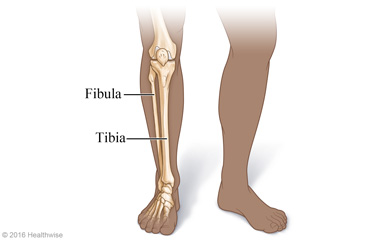
Overview
A stress fracture of the lower leg is a tiny hairline crack in the bone. It may happen in the tibia (shinbone), the larger bone of the lower leg. Or it may happen in the fibula, the smaller bone of the lower leg.
A lower leg hairline fracture often is caused by ongoing overuse, such as from regular long-distance running. Your doctor may have put your leg in a brace, splint, or cast to allow it to heal or to keep it stable until you see another doctor. It may take a few weeks to a few months to heal. It can be frustrating to slow down or stop your activities. But going back to exercise too soon can cause the injury to get worse and make healing take even longer.
You heal best when you take good care of yourself. Eat a variety of healthy foods, and don't smoke.
Follow-up care is a key part of your treatment and safety. Be sure to make and go to all appointments, and call your doctor if you are having problems. It's also a good idea to know your test results and keep a list of the medicines you take.
How can you care for yourself at home?
- Rest your leg as much as you can for as long as your doctor advises. Follow your doctor's instructions for using crutches, a brace, or a splint.
- Ask your doctor before you change your activity level or go back to your usual exercise. Too much activity or weight on the leg with the fracture can cause it to get worse.
- Put ice or a cold pack on your leg for 10 to 20 minutes at a time. Put a thin cloth between the ice and your skin.
- Be safe with medicines. Read and follow all instructions on the label.
- If the doctor gave you a prescription medicine for pain, take it as prescribed.
- If you are not taking a prescription pain medicine, ask your doctor if you can take an over-the-counter medicine.
- Do exercises or physical therapy as directed by your doctor.
When should you call for help?
Call 911 anytime you think you may need emergency care. For example, call if:
- You have severe pain.
Call your doctor now or seek immediate medical care if:
- You have new weakness in your leg.
- You fall on or hurt the injured leg.
- Your pain gets much worse.
- Your leg or foot is cold or pale or changes color.
Watch closely for changes in your health, and be sure to contact your doctor if:
- You do not get better as expected.
Where can you learn more?
Go to http://www.healthwise.net/patientEd
Enter N176 in the search box to learn more about "Lower Leg Stress Fracture: Care Instructions".
Current as of: July 31, 2024
Author: Ignite Healthwise, LLC Staff
Clinical Review Board
All Ignite Healthwise, LLC education is reviewed by a team that includes physicians, nurses, advanced practitioners, registered dieticians, and other healthcare professionals.

